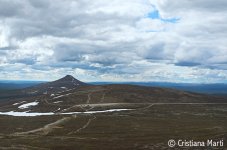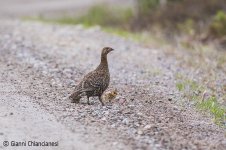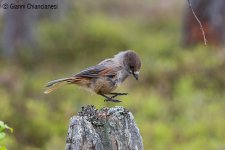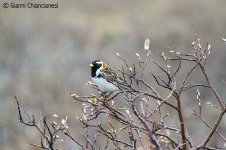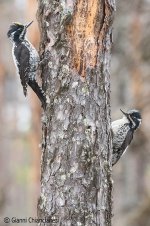
We spent 11 days in Sweden, mostly in the central region of Dalarna, near the Norwegian border. We were based in Särna, at an hostel run by an Italian nature photographer and his wife, who have been living here for 8 years or so. You get a private room and the use of large, well-equipped communal kitchen. As a bonus, the owners will give you tips on where to find the species you are looking for, be it birds, mammals or plants. Given the usual cost of accommodation in Scandinavia, this place is a real find.
We flew from Rome Ciampino to Göteborg with Ryanair, hired a car and drove the 540 km. north to Särna. A bit of a pain, but flights to Oslo, which is much closer, cost twice as much when we booked.
This part of Sweden is mostly managed boreal forest (taiga), interspersed with bogs, lakes, streams and a few tundra plateaus. It is ideal for a taster of arctic species, without the harsher temperatures and more difficult travel encountered at higher latitudes. We saw all our target species minus Capercaillie and Gyrfalcon, which for the first time in 8 years hadn't nested in the usual spot in Fulufjället National Park :-C.
We drove around a lot, mostly on the well-maintained unpaved roads that cut through the never-ending forests, but there are a few places which we visited more than once and that we can recommend:
- Fulufjället National Park,
30 km. from the hostel, is a rocky plateau in the middle of boreal forest, boasting Sweden's highest waterfall. As I said Gyrfalcons nested here for 8 years running (see Capercaillie's trip report here), but not this year. It is still worth a visit for its fantastic views and to have a chance to spot Siberian Jays, Ring Ouzels, Dippers and Three-toed Woodpeckers. Golden Eagles also nest in the Park, as well as waders, both in the forest bogs and in the lakes on the plateau.
- Nipfjället, a rocky plateau (around 1000 m. high) just north of Idre, a well-known ski resort in Sweden, with some arctic specialties, such as Ptarmigan, Snow Bunting and Dotterel. The views from the top are breathtaking.
- Lake Glysjön, 18 km. south of Särna, also mentioned by Capercaillie in his trip report above. A nesting site for Arctic Terns, Whooper Swans, Cranes etc.
- The Flatruet plateau, 150 km. north of Särna, where the real tundra begins. This is a well-known spot for birders and photographers because of the several arctic species which can be found here. Long-tailed Skua, Red-necked Phalarope, Common Scoter, Cranes, Lapland Bunting, Bluethroat, Ruff, White-tailed Eagle, Dotterel, Golden Plover. Even Snowy Owls are rumoured to be seen here every once in a while.
June 17
We land at Göteborg Landvetter airport around 10am, pick up our rental car and drive the 540 km. to Särna in the rain (and after a sleepless night spent driving to Rome Ciampino and sitting on the airport's steps as the doors didn't open until 4.30 :C). Needless to say we didn't see much, apart from the first Common Cranes and Fieldfares.
June 18
Lots of activity around the feeders in the hostel's garden, Greenfinches, Siskins, Tree Sparrows, more Fieldfares, beautiful soemmerringii Jackdaws and, most notably, Nuthatches of the northern subspecies europaea and Red Squirrels.
We drive to the main entrance of Fulufjället National Park, and, since it's still raining, we take shelter in the Visitor's Centre and look at what wildlife we can see through the panoramic window, more of a wall, actually (the first pair of Greenshanks, a Sparrowhawk, White Wagtails, Bramblings, a Green Sandpiper). After a coffee with the traditional cinnamon rolls in the cafe next door the rain eases a little and we decide to drive to another entrance of the park to try for Three-toed Woodpecker. Along the way we spot Cranes, Tufted Ducks, more Greenshanks, a fantastic Golden Eagle which flies low over the trees, crossing the road in front of us, and one Goldcrest. In the Göljådalen valley no woodpeckers, but more Bramblings, Chaffinches, Wrens and a few unexpected Spotted Flycatchers.
We go back to Särna the long way, taking a dirt road that winds through forests and lakes. Here we see the first Whooper Swans, a Common Sandpiper, the first Mistle Thrush and the first Kestrel.
Back in Särna we have a look at the lake and see Arctic Terns, Curlew, Osprey, Black Throated Diver, Goldeneye, Swallows and Sand Martins.
June 19
The sun is shining so we drive to the Nipfjället plateau, where several groups of Reindeer are grazing (much to the delight of our daughter). We take a walk around the plateau and see Wheatears, the first of the "millions" of Meadow Pipits we will see during this trip, a lost-looking Kestrel, some Golden Plovers and the only Ptarmigan of the trip. A Pied Flycatcher flies across the road as we are returning to Idre.
Another day, another forest road, this time south of Idre, where a female Black Grouse with 4-5 chicks crosses the road in front of us.
We decide to try the Göljådalen valley again and are rewarded with two Golden Eagles, the first Siberian Jays of the trip, another Greenshank, but this time with chicks, and a Merlin.
June 20
Another fine day, with temperatures around 12°-14°, so we decide to go to Flatruet for some tundra species. During the 2 1/2 hours' drive we see several groups of Reindeer, one Red-breasted Merganser, the first Cuckoo of the trip and the first House Martins. More Reindeer on the plateau, alongside Reed Bunting, a couple of Bluethroats, Common Sandpiper, Redshank, Lapwing, Golden Plovers, a Kestrel. And then: Red-necked Phalarope, Common Scoter, a few Ruff in breeding plumage, Tufted Duck and Long-tailed Duck. We follow the road north an then to the north-east towards Storsjön, where we see Common Gull, Black-headed Gull, fantastic Little Gulls in breeding plumage, Arctic Terns, Black Throated Diver, Red- Throated Diver, Horned Grebe, Teal.
June 21
We head south towards Lake Glysjön. Along the road the first Raven and a Kestrel; from the one remaining hide on the lake (apparently the other ones were taken down because they were falling apart): Whooper Swans, Cranes, Black-headed Gulls, Tufted Ducks, Goldeneyes, Arctic Terns, Redstart, a Black Woodpecker on the other side of the lake, Great Spotted Woodpecker, Hobby, Greenshanks, Tree Pipit and a family of Elks.
Back in Särna we try a small road leading to a quarry where a Yellowhammer and a Garden Warbler are singing. On the other side of the lake the usual things plus Dipper at the falls nearby.
June 22
Back in Fulufjället National Park we take the trail that leads to base of the Njupeskar falls, the tallest in Sweden, and then to the top of the rocky plateau above. We add to the list Yellow Wagtail thunbergi and Ring Ouzel. Back at the Visitors' centre 4 Siberian Jays delight the visitors around the cafe.
June 23
Rain in Särna, so we head south towards Mora, where our host has suggested a visit to a Reserve on the lake Orsasjön. We park next to a viewing platform, where another birder, who turns out to be local, has already set up his scope. Besides the usual things we see several new species for the trip: Common Terns, Mute Swans, Canada Geese, one Greylag Goose, Wigeons, a single Gadwall, several Common Snipe, a Spotted Redshank and Wood Sandpiper, plus more Ruff in breeding plumage, Lapwings, another Hobby, Swallows, Curlews, Common Gulls and the usual Greenshanks.
June 24
Despite the cold, we decide that a second visit to Flatruet is in order. On the way we see Whooper Swans, Arctic Terns, 3 pairs of Velvet Scoter and another Red-breasted Merganser. Up on the plateau the temperature is around 5° and we are almost alone (the previous time it had been pretty busy with birders, photographers and hikers). We see a White-tailed Eagle far away, mobbed by Long-Tailed Skuas. The Skuas then get closer and we get good views both in flight and perched on a rocky outcrop. We go for a walk along a trail across the tundra and hear, then see 3 Lapland Buntings singing on top of a clump of bushes. On the way back to the car we flush a Willow Grouse. Then a juvenile Golden Eagle with two possible adults in the distance and a Raven mobbed by a Long-tailed Skua a 100 metres away. Plus the "usual" stuff: Cranes, Green and Redshanks, Reed Buntings, Bramblings, a lone Kestrel. We also hear, but do not see, Dotterels in the distance.
June 25
Back to the viewing platform at lake Glysjön we add a few more species to the list: Marsh Harrier, a delightful Crested Tit and, finally, a pair of Three-toed Woodpeckers, mobbed by an angry Brambling.
In the afternoon, we return to the falls near Särna for more views of Dipper and an additional Grey Wagtail, plus another Hobby.
June 26
A cold day. We head back to Nipfjället, but it's very windy and bitterly cold and we don't see much apart from the ubiquitous Meadow Pipits.
June 27
We leave Särna at 7am, heading for Göteborg, where we have booked a room at the airport Hotel, since our plane leaves early on the morning of the 28.
Along the way we see 3 Common Buzzards, the first, and last of the trip, and just north of Göteborg we make a detour to have a look at the Bohuslän islands, on the west coast, as suggested by our hosts. On the island of Tjörn, connected to the mainland by a spectacular bridge, we add to the list Whitethroat, Great Black-backed Gull, House Sparrow, Goldfinch, Oystercatcher and Cormorant, among lots of Canada and Greylag Geese and both species of Terns.
Total 105 species, as I said we only missed one of our target species, Capercaillie, as the other three that can normally be seen in the area, Gyrfalcon, Hawk Owl and Tengmalm's Owl, hadn't nested in the usual places, probably because of the weather, which had been unusually cold and wet for most of the spring. Beautiful and unusual landscapes for us southerners and the warm welcome (and helpful tips) from our hosts made this a truly memorable trip, which we can recommend to all birders.
Species Checklist (*heard):
1) Red Throated Diver
2) Black Throated Diver
3) Horned Grebe
4) Cormorant
5) Mute Swan
6) Whooper Swan
7) Greylag Goose
8) Canada Goose
9) Mallard
10) Gadwall
11) Wigeon
12) Teal
13) Tufted Duck
14) Common Scoter
15) Velvet Scoter
16) Long-tailed Duck.
17) Goldeneye
18) Red-breasted Merganser
19) White-tailed Eagle
20) Osprey
21) Golden Eagle
22) Marsh Harrier
23) Buzzard
24) Sparrowhawk
25) Kestrel
26) Hobby
27) Merlin
28) Willow Grouse
29) Ptarmigan
30) Black Grouse
31) Common Crane
32) Oystercatcher
33) Dotterel *
34) Golden Plover
35) Lapwing
36) Wood Sandpiper
37) Green Sandpiper
38) Common Sandpiper
39) Redshank
40) Spotted Redshank
41) Greenshank
42) Curlew
43) Common Snipe
44) Red-necked Phalarope
45) Ruff
46) Long-tailed Skua
47) Black-headed Gull
48) Common Gull
49) Herring Gull
50) Great Black-backed Gull
51) Little Gull
52) Common Tern
53) Arctic Tern
54) Cuckoo
55) Swift
56) Black Woodpecker
57) Great Spotted Woodpecker
58) Three-toed Woodpecker
59) Sand Martin
60) Barn Swallow
61) House Martin
62) Meadow Pipit
63) Tree Pipit
64) White Wagtail
65) Yellow Wagtail thunbergi
66) Grey wagtail
67) Wren *
68) Dipper
69) Robin
70) Bluethroat
71) Common Redtstart
72) Northern Wheatear
73) Song Thrush
74) Redwing
75) Mistle Thrush
76) Fieldfare
77) Blackbird
78) Ring Ouzel
79) Garden Warbler
80) Whitethroat
81) Willow Warbler
82) Goldcrest
83) Spotted Flycatcher
84) Pied Flycatcher
85) Great Tit
86) Blue Tit
87) Crested Tit
88) Nuthatch europaea
89) Magpie
90) Jay
91) Siberian Jay
92) Jackdaw soemmerringii
93) Hooded Crow
94) Raven
95) Starling
96) House Sparrow
97) Tree Sparrow
98) Chaffinch
99) Brambling
100) Goldfinch
101) Greenfinch
102) Siskin
103) Reed Bunting
104) Lapland Bunting
105) Yellowhammer
We flew from Rome Ciampino to Göteborg with Ryanair, hired a car and drove the 540 km. north to Särna. A bit of a pain, but flights to Oslo, which is much closer, cost twice as much when we booked.
This part of Sweden is mostly managed boreal forest (taiga), interspersed with bogs, lakes, streams and a few tundra plateaus. It is ideal for a taster of arctic species, without the harsher temperatures and more difficult travel encountered at higher latitudes. We saw all our target species minus Capercaillie and Gyrfalcon, which for the first time in 8 years hadn't nested in the usual spot in Fulufjället National Park :-C.
We drove around a lot, mostly on the well-maintained unpaved roads that cut through the never-ending forests, but there are a few places which we visited more than once and that we can recommend:
- Fulufjället National Park,
30 km. from the hostel, is a rocky plateau in the middle of boreal forest, boasting Sweden's highest waterfall. As I said Gyrfalcons nested here for 8 years running (see Capercaillie's trip report here), but not this year. It is still worth a visit for its fantastic views and to have a chance to spot Siberian Jays, Ring Ouzels, Dippers and Three-toed Woodpeckers. Golden Eagles also nest in the Park, as well as waders, both in the forest bogs and in the lakes on the plateau.
- Nipfjället, a rocky plateau (around 1000 m. high) just north of Idre, a well-known ski resort in Sweden, with some arctic specialties, such as Ptarmigan, Snow Bunting and Dotterel. The views from the top are breathtaking.
- Lake Glysjön, 18 km. south of Särna, also mentioned by Capercaillie in his trip report above. A nesting site for Arctic Terns, Whooper Swans, Cranes etc.
- The Flatruet plateau, 150 km. north of Särna, where the real tundra begins. This is a well-known spot for birders and photographers because of the several arctic species which can be found here. Long-tailed Skua, Red-necked Phalarope, Common Scoter, Cranes, Lapland Bunting, Bluethroat, Ruff, White-tailed Eagle, Dotterel, Golden Plover. Even Snowy Owls are rumoured to be seen here every once in a while.
June 17
We land at Göteborg Landvetter airport around 10am, pick up our rental car and drive the 540 km. to Särna in the rain (and after a sleepless night spent driving to Rome Ciampino and sitting on the airport's steps as the doors didn't open until 4.30 :C). Needless to say we didn't see much, apart from the first Common Cranes and Fieldfares.
June 18
Lots of activity around the feeders in the hostel's garden, Greenfinches, Siskins, Tree Sparrows, more Fieldfares, beautiful soemmerringii Jackdaws and, most notably, Nuthatches of the northern subspecies europaea and Red Squirrels.
We drive to the main entrance of Fulufjället National Park, and, since it's still raining, we take shelter in the Visitor's Centre and look at what wildlife we can see through the panoramic window, more of a wall, actually (the first pair of Greenshanks, a Sparrowhawk, White Wagtails, Bramblings, a Green Sandpiper). After a coffee with the traditional cinnamon rolls in the cafe next door the rain eases a little and we decide to drive to another entrance of the park to try for Three-toed Woodpecker. Along the way we spot Cranes, Tufted Ducks, more Greenshanks, a fantastic Golden Eagle which flies low over the trees, crossing the road in front of us, and one Goldcrest. In the Göljådalen valley no woodpeckers, but more Bramblings, Chaffinches, Wrens and a few unexpected Spotted Flycatchers.
We go back to Särna the long way, taking a dirt road that winds through forests and lakes. Here we see the first Whooper Swans, a Common Sandpiper, the first Mistle Thrush and the first Kestrel.
Back in Särna we have a look at the lake and see Arctic Terns, Curlew, Osprey, Black Throated Diver, Goldeneye, Swallows and Sand Martins.
June 19
The sun is shining so we drive to the Nipfjället plateau, where several groups of Reindeer are grazing (much to the delight of our daughter). We take a walk around the plateau and see Wheatears, the first of the "millions" of Meadow Pipits we will see during this trip, a lost-looking Kestrel, some Golden Plovers and the only Ptarmigan of the trip. A Pied Flycatcher flies across the road as we are returning to Idre.
Another day, another forest road, this time south of Idre, where a female Black Grouse with 4-5 chicks crosses the road in front of us.
We decide to try the Göljådalen valley again and are rewarded with two Golden Eagles, the first Siberian Jays of the trip, another Greenshank, but this time with chicks, and a Merlin.
June 20
Another fine day, with temperatures around 12°-14°, so we decide to go to Flatruet for some tundra species. During the 2 1/2 hours' drive we see several groups of Reindeer, one Red-breasted Merganser, the first Cuckoo of the trip and the first House Martins. More Reindeer on the plateau, alongside Reed Bunting, a couple of Bluethroats, Common Sandpiper, Redshank, Lapwing, Golden Plovers, a Kestrel. And then: Red-necked Phalarope, Common Scoter, a few Ruff in breeding plumage, Tufted Duck and Long-tailed Duck. We follow the road north an then to the north-east towards Storsjön, where we see Common Gull, Black-headed Gull, fantastic Little Gulls in breeding plumage, Arctic Terns, Black Throated Diver, Red- Throated Diver, Horned Grebe, Teal.
June 21
We head south towards Lake Glysjön. Along the road the first Raven and a Kestrel; from the one remaining hide on the lake (apparently the other ones were taken down because they were falling apart): Whooper Swans, Cranes, Black-headed Gulls, Tufted Ducks, Goldeneyes, Arctic Terns, Redstart, a Black Woodpecker on the other side of the lake, Great Spotted Woodpecker, Hobby, Greenshanks, Tree Pipit and a family of Elks.
Back in Särna we try a small road leading to a quarry where a Yellowhammer and a Garden Warbler are singing. On the other side of the lake the usual things plus Dipper at the falls nearby.
June 22
Back in Fulufjället National Park we take the trail that leads to base of the Njupeskar falls, the tallest in Sweden, and then to the top of the rocky plateau above. We add to the list Yellow Wagtail thunbergi and Ring Ouzel. Back at the Visitors' centre 4 Siberian Jays delight the visitors around the cafe.
June 23
Rain in Särna, so we head south towards Mora, where our host has suggested a visit to a Reserve on the lake Orsasjön. We park next to a viewing platform, where another birder, who turns out to be local, has already set up his scope. Besides the usual things we see several new species for the trip: Common Terns, Mute Swans, Canada Geese, one Greylag Goose, Wigeons, a single Gadwall, several Common Snipe, a Spotted Redshank and Wood Sandpiper, plus more Ruff in breeding plumage, Lapwings, another Hobby, Swallows, Curlews, Common Gulls and the usual Greenshanks.
June 24
Despite the cold, we decide that a second visit to Flatruet is in order. On the way we see Whooper Swans, Arctic Terns, 3 pairs of Velvet Scoter and another Red-breasted Merganser. Up on the plateau the temperature is around 5° and we are almost alone (the previous time it had been pretty busy with birders, photographers and hikers). We see a White-tailed Eagle far away, mobbed by Long-Tailed Skuas. The Skuas then get closer and we get good views both in flight and perched on a rocky outcrop. We go for a walk along a trail across the tundra and hear, then see 3 Lapland Buntings singing on top of a clump of bushes. On the way back to the car we flush a Willow Grouse. Then a juvenile Golden Eagle with two possible adults in the distance and a Raven mobbed by a Long-tailed Skua a 100 metres away. Plus the "usual" stuff: Cranes, Green and Redshanks, Reed Buntings, Bramblings, a lone Kestrel. We also hear, but do not see, Dotterels in the distance.
June 25
Back to the viewing platform at lake Glysjön we add a few more species to the list: Marsh Harrier, a delightful Crested Tit and, finally, a pair of Three-toed Woodpeckers, mobbed by an angry Brambling.
In the afternoon, we return to the falls near Särna for more views of Dipper and an additional Grey Wagtail, plus another Hobby.
June 26
A cold day. We head back to Nipfjället, but it's very windy and bitterly cold and we don't see much apart from the ubiquitous Meadow Pipits.
June 27
We leave Särna at 7am, heading for Göteborg, where we have booked a room at the airport Hotel, since our plane leaves early on the morning of the 28.
Along the way we see 3 Common Buzzards, the first, and last of the trip, and just north of Göteborg we make a detour to have a look at the Bohuslän islands, on the west coast, as suggested by our hosts. On the island of Tjörn, connected to the mainland by a spectacular bridge, we add to the list Whitethroat, Great Black-backed Gull, House Sparrow, Goldfinch, Oystercatcher and Cormorant, among lots of Canada and Greylag Geese and both species of Terns.
Total 105 species, as I said we only missed one of our target species, Capercaillie, as the other three that can normally be seen in the area, Gyrfalcon, Hawk Owl and Tengmalm's Owl, hadn't nested in the usual places, probably because of the weather, which had been unusually cold and wet for most of the spring. Beautiful and unusual landscapes for us southerners and the warm welcome (and helpful tips) from our hosts made this a truly memorable trip, which we can recommend to all birders.
Species Checklist (*heard):
1) Red Throated Diver
2) Black Throated Diver
3) Horned Grebe
4) Cormorant
5) Mute Swan
6) Whooper Swan
7) Greylag Goose
8) Canada Goose
9) Mallard
10) Gadwall
11) Wigeon
12) Teal
13) Tufted Duck
14) Common Scoter
15) Velvet Scoter
16) Long-tailed Duck.
17) Goldeneye
18) Red-breasted Merganser
19) White-tailed Eagle
20) Osprey
21) Golden Eagle
22) Marsh Harrier
23) Buzzard
24) Sparrowhawk
25) Kestrel
26) Hobby
27) Merlin
28) Willow Grouse
29) Ptarmigan
30) Black Grouse
31) Common Crane
32) Oystercatcher
33) Dotterel *
34) Golden Plover
35) Lapwing
36) Wood Sandpiper
37) Green Sandpiper
38) Common Sandpiper
39) Redshank
40) Spotted Redshank
41) Greenshank
42) Curlew
43) Common Snipe
44) Red-necked Phalarope
45) Ruff
46) Long-tailed Skua
47) Black-headed Gull
48) Common Gull
49) Herring Gull
50) Great Black-backed Gull
51) Little Gull
52) Common Tern
53) Arctic Tern
54) Cuckoo
55) Swift
56) Black Woodpecker
57) Great Spotted Woodpecker
58) Three-toed Woodpecker
59) Sand Martin
60) Barn Swallow
61) House Martin
62) Meadow Pipit
63) Tree Pipit
64) White Wagtail
65) Yellow Wagtail thunbergi
66) Grey wagtail
67) Wren *
68) Dipper
69) Robin
70) Bluethroat
71) Common Redtstart
72) Northern Wheatear
73) Song Thrush
74) Redwing
75) Mistle Thrush
76) Fieldfare
77) Blackbird
78) Ring Ouzel
79) Garden Warbler
80) Whitethroat
81) Willow Warbler
82) Goldcrest
83) Spotted Flycatcher
84) Pied Flycatcher
85) Great Tit
86) Blue Tit
87) Crested Tit
88) Nuthatch europaea
89) Magpie
90) Jay
91) Siberian Jay
92) Jackdaw soemmerringii
93) Hooded Crow
94) Raven
95) Starling
96) House Sparrow
97) Tree Sparrow
98) Chaffinch
99) Brambling
100) Goldfinch
101) Greenfinch
102) Siskin
103) Reed Bunting
104) Lapland Bunting
105) Yellowhammer
Attachments
Last edited:




